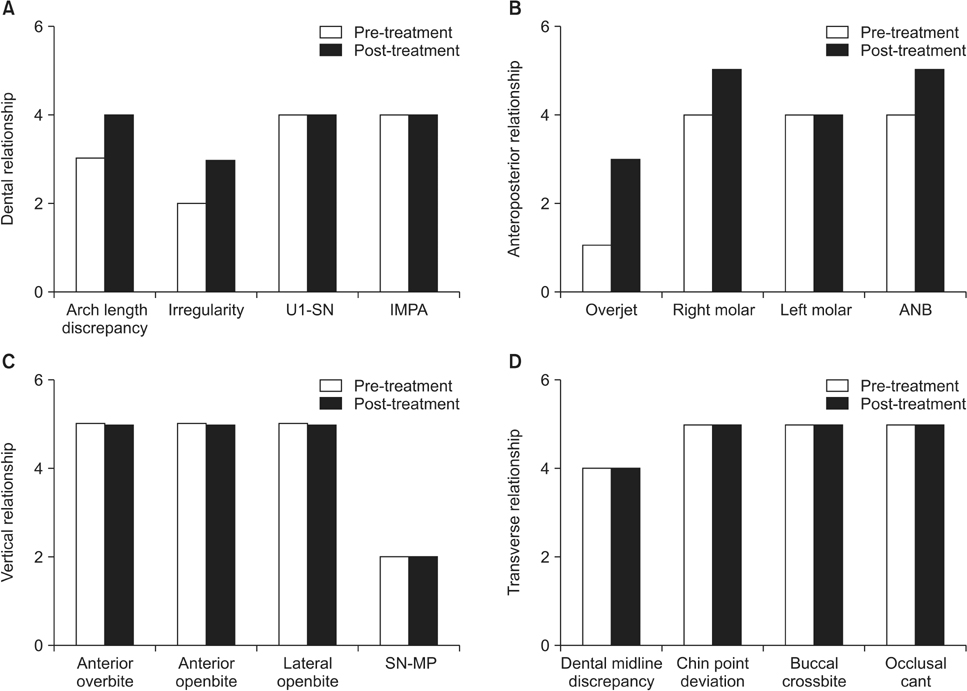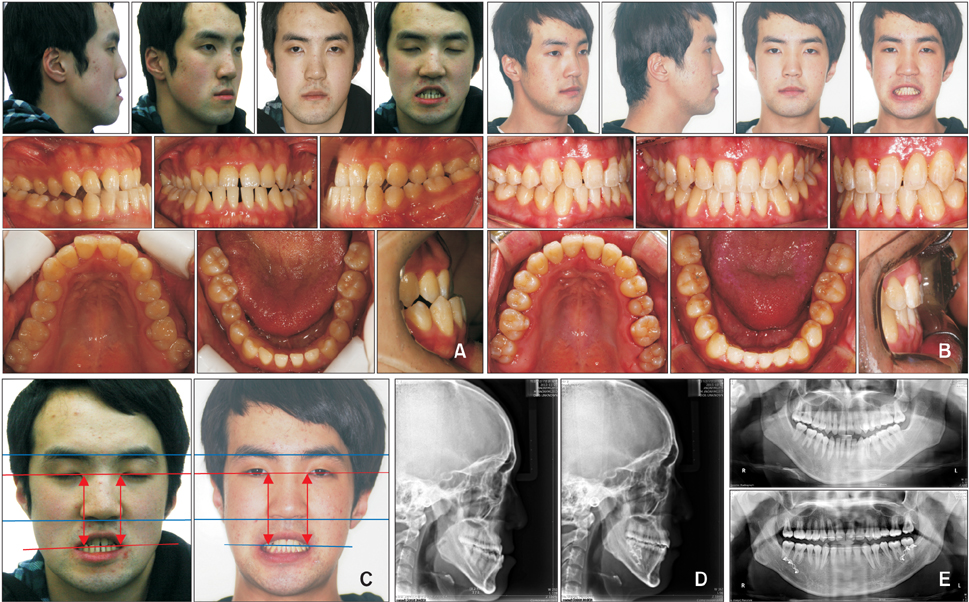Korean J Orthod.
2016 Jul;46(4):199-211. 10.4041/kjod.2016.46.4.199.
The Improvement and Completion of Outcome index: A new assessment system for quality of orthodontic treatment
- Affiliations
-
- 1Department of Orthodontics, Uijeongbu St. Mary's Hospital, the Catholic University of Korea, Uijeongbu, Korea.
- 2Department of Orthodontics, Seoul St. Mary's Hospital, the Catholic University of Korea, Seoul, Korea.
- 3Department of Dental Services Management and Informatics, School of Dentistry, Seoul National University, Seoul, Korea.
- 4Department of Oral Pathology, School of Dentistry, Seoul National University, Seoul, Korea.
- 5Department of Orthodontics, School of Dentistry, Seoul National University, Seoul, Korea. drwhite@unitel.co.kr
- 6Dental Research Institute, Seoul National University, Seoul, Korea.
- KMID: 2392200
- DOI: http://doi.org/10.4041/kjod.2016.46.4.199
Abstract
OBJECTIVE
Given the considerable disagreement between the Peer Assessment Rating (PAR) index and the American Board of Orthodontics Cast-Radiograph Evaluation, we aimed to develop a novel assessment system-the Improvement and Completion of Outcome (ICO) index-to evaluate the outcome of orthodontic treatment.
METHODS
Sixteen criteria from 4 major categories were established to represent the pretreatment malocclusion status, as well as the degree of improvement and level of completion of outcome during/after treatment: dental relationship (arch length discrepancy, irregularity, U1-SN, and IMPA); anteroposterior relationship (overjet, right and left molar position, ANB); vertical relationship (anterior overbite, anterior open-bite, lateral open-bite, SN-MP); and transverse relationship (dental midline discrepancy, chin point deviation, posterior cross-bite, occlusal plane cant). The score for each criterion was defined from 0 or −1 (worst) to 5 (ideal value or normal occlusion) in gradations of 1. The sum of the scores in each category indicates the area and extent of the problems. Improvement and completion percentages were estimated based on the pre- and post-treatment total scores and the maximum total score. If the completion percentage exceeded 80%, treatment outcome was considered successful.
RESULTS
Two cases, Class I malocclusion and skeletal Class III malocclusion, are presented to represent the assessment procedure using the ICO index. The difference in the level of improvement and completion of treatment outcome can be clearly explained by using 2 percentage values.
CONCLUSIONS
Thus, the ICO index enables the evaluation of the quality of orthodontic treatment objectively and consecutively throughout the entire treatment process.
Keyword
Figure
Cited by 1 articles
-
Outcomes of comprehensive fixed appliance orthodontic treatment: A systematic review with meta-analysis and methodological overview
Spyridon N. Papageorgiou, Damian Höchli, Theodore Eliades
Korean J Orthod. 2017;47(6):401-413. doi: 10.4041/kjod.2017.47.6.401.
Reference
-
1. Gottlieb EL. Grading your orthodontic treatment results. J Clin Orthod. 1975; 9:155–161.2. Shaw WC, Richmond S, O'Brien KD. The use of occlusal indices: a European perspective. Am J Orthod Dentofacial Orthop. 1995; 107:1–10.
Article3. Kokich VG. How good are you? Am J Orthod Dentofacial Orthop. 2011; 140:1.
Article4. Richmond S, Shaw WC, O'Brien KD, Buchanan IB, Jones R, Stephens CD, et al. The development of the PAR Index (Peer Assessment Rating): reliability and validity. Eur J Orthod. 1992; 14:125–139.
Article5. Richmond S, Shaw WC, Roberts CT, Andrews M. The PAR Index (Peer Assessment Rating): methods to determine outcome of orthodontic treatment in terms of improvement and standards. Eur J Orthod. 1992; 14:180–187.
Article6. DeGuzman L, Bahiraei D, Vig KW, Vig PS, Weyant RJ, O'Brien K. The validation of the Peer Assessment Rating index for malocclusion severity and treatment difficulty. Am J Orthod Dentofacial Orthop. 1995; 107:172–176.
Article7. al Yami EA, Kuijpers-Jagtman AM, van't Hof MA. Occlusal outcome of orthodontic treatment. Angle Orthod. 1998; 68:439–444.8. Lieber WS, Carlson SK, Baumrind S, Poulton DR. Clinical use of the ABO-Scoring Index: reliability and subtraction frequency. Angle Orthod. 2003; 73:556–564.9. Fox NA, Chapple JR. Measuring failure of orthodontic treatment: a comparison of outcome indicators. J Orthod. 2004; 31:319–322.
Article10. Deguchi T, Honjo T, Fukunaga T, Miyawaki S, Roberts WE, Takano-Yamamoto T. Clinical assessment of orthodontic outcomes with the peer assessment rating, discrepancy index, objective grading system, and comprehensive clinical assessment. Am J Orthod Dentofacial Orthop. 2005; 127:434–443.
Article11. Onyeaso CO, Begole EA. Relationship between index of complexity, outcome and need, dental aesthetic index, peer assessment rating index, and American Board of Orthodontics objective grading system. Am J Orthod Dentofacial Orthop. 2007; 131:248–252.
Article12. Arruda AO. Occlusal indexes as judged by subjective opinions. Am J Orthod Dentofacial Orthop. 2008; 134:671–675.
Article13. Son WS, Cha KS, Chung DH, Kim TW. Quantitative evaluation and affecting factors of post-treatment relapse tendency. Korean J Orthod. 2011; 41:154–163.
Article14. Hong MH, Kook YA, Baek SH, Kim MK. Comparison of treatment outcome assessment for class I malocclusion patients: peer assessment rating versus American board of orthodontics-objective grading system. J Korean Dent Sci. 2014; 7:6–15.
Article15. Lee SM, Lee JW. Computerized occlusal analysis: correlation with occlusal indexes to assess the outcome of orthodontic treatment or the severity of malocculusion. Korean J Orthod. 2016; 46:27–35.
Article16. Hinman C. The Dental Practice Board. Orthodontics--the current status. Br J Orthod. 1995; 22:287–290.
Article17. Roberts CT, Richmond S. The design and analysis of reliability studies for the use of epidemiological and audit indices in orthodontics. Br J Orthod. 1997; 24:139–147.
Article18. Casko JS, Vaden JL, Kokich VG, Damone J, James RD, Cangialosi TJ, et al. Objective grading system for dental casts and panoramic radiographs. American Board of Orthodontics. Am J Orthod Dentofacial Orthop. 1998; 114:589–599.19. Hong MH. A self-assessment system for assuring the quality of orthodontic treatment outcome [PhD dissertation]. Seoul: Seoul National University;2015.20. Huang GJ, Richmond S, Vig KWL. Evidence-based orthodontics. Chichester: Wiley-Blackwell;2011.21. Baek SH, Yang WS. A soft tissue analysis on facial esthetics of Korean young adults. Korean J Orthod. 1991; 21:131–170.
- Full Text Links
- Actions
-
Cited
- CITED
-
- Close
- Share
- Similar articles
-
- Quality Indicators and Outcome Measures of Endoscopy in the National Cancer Screening Program
- The Relationships between Orthodontic Treatment, Oral Health-Related Quality of Life, and Happiness of among Some High School Students
- A Study on Assessment System for Nursing Bachelor Degree Program Outcomes: Focused on Communication Ability Improvement
- A Review of Quality Management and Improvement of Trauma Fee Schedule in Regional Trauma Center
- Changes in Fatigue and the Quality of Life of Cancer Patients Receiving Radiotherapy





